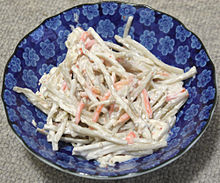Description
Japanese Organic Food Series
🚚 The Fastest Delivery Time : 2-day delivery.
🐝 Supplier / Place Of Origin:Japanese Organic Food Series / Japan
🔖 Certification: Japan Organic JAS Certified
🌱 Producer Introduction:
We will deliver safe and secure foods that are attracting attention in the modern society where health consciousness is increasing,such as organic and food additive-free, as much as possible to the dining table not only in Japan but also around the world.
✈️ We deliver carefully selected Japanese ingredients to local health-conscious people through local supermarkets and shops as well as overseas Japanese food specialty stores and Japanese restaurants. In addition to processed foods, we will guide you to fresh fruits and vegetables, meat and seafood in a form that meets local needs.
🌱 Supplier Products:
🛍 Product Information (Main) (English):
Binomial Name:Arctium lappa L.
Chinese Name:牛蒡
Other Names:Edible Burdock | Greater Burdock
Product Description:Burdock is a root vegetable, biennial herb. In ancient China, burdock was called "Niufang" or the tail of a cow, and was used as a medicinal herb. Burdock has been used medicinally for a long time in China, but it has only been used for consumption in recent years. Burdock is also one of the Japanese favorite ingredients, and it is also known as the king of vegetables. Burdock is rich in dietary fiber, has the effect of rectifying the intestinal environment, and can effectively relieve constipation, and the lignin in it has anti-cancer effect and can effectively prevent colorectal cancer; inulin can prevent blood sugar The value rises rapidly, which is helpful for diabetic patients. In recent years, studies have pointed out that eating burdock regularly can also help anti-aging.
Burdock originated in Asia such as China and India, and also has wild varieties in Japan, Europe, and North America.
Variety:The varieties of edible burdock are mostly introduced from Japan, and there are common varieties and early summer varieties. Common varieties: tall plants, large leaves, tender meat, strong aroma, good quality.
Early summer varieties: the same tender meat, strong aroma, good quality, but softer texture.
Supply Season:The abundant production period is usually from November to January. In addition, the harvest period of early maturity varieties is from May to June.
Storage Method:The water content of burdock is easy to lose, so it should be eaten as soon as possible. Burdock does not need to be refrigerated for preservation, wrap it in newspaper or plastic wrap, and put it in a cool and well-ventilated place.
#Should Be / Avoided:
Appropriate: Because burdock contains inulin, which can help lower blood sugar, it is suitable for long-term consumption by diabetics. Contraindications: People who are prone to allergies and those with diarrhea due to spleen deficiency should not eat more.
*Edible Compatibility:
Availability: Not reported in the literature. Xiang Ke: No literature report.
薬用
伝統的な中国医学と民間療法
伝統的な中国医学(TCM)で使用されてきた長い歴史があり、根、果実、葉などのさまざまな部分が使用されます。その果実はゴボウと呼ばれる漢方薬であり、日本薬局方にも収録されています。解毒作用があると考えられており、方風散、財界子精湯、カロテノイドなどの処方に使用されています。これらのハーブの適応症はすべて長期使用に基づいています。
欧米ではごぼうは薬草としてハーブティーなどに使われており、ごぼう油と呼ばれるごぼう油抽出物は頭皮のトリートメントとしても使われています。
日本には中国から薬草として伝わりました。薬用としては、発汗作用や利尿作用のある根をゴボウといい、浮腫や喉の痛み、解毒などに使われる種子をゴボウといいます。民間療法では、種子を直接食べるか、煎じ薬を使用して乳腺炎を治療することも知られています。ごぼうは解熱作用が強いハーブで、風邪や高熱の咳に効果があると言われています。湿疹、おでき、腫れなどの化膿性疾患の治療には、ゴボウの煎じ薬(水抽出物)5~8 gを水600 ccに半分の量で1日3回に分けて加えます[56]。風邪、のどの痛み、咳などの場合は、ごぼう2〜3gを1日3回に分けて400ccの水に溶かしてお召し上がりください。むくみの治療には、ごぼうをすりつぶして粉末にし、1日3〜6グラムを3回に分けてお召し上がりください。神経痛、リウマチ、関節炎の場合は、生の葉を柔らかくなるまで焙煎し、患部に冷湿布を当てると痛みが軽減されると言われています。夏に集めた葉は日の当たる場所に保管し、入浴剤やうがい薬として使われます。口内炎、扁桃炎、歯肉の腫れなどの炎症性疾患を効果的に予防します。
Cooking Skills:Since the aroma and flavor of burdock are mostly in the position near the skin, try not to peel it and cook it directly. Although soaking in water can remove astringent liquid and make the color beautiful, but the aroma and flavor are also lost, so soaking time should not be too long. Burdock contains a lot of iron, which is easy to oxidize and discolor. The treated burdock can be soaked in water to prevent discoloration.
Notes:Burdock has the effect of lowering cholesterol, and eating it regularly can prevent arteriosclerosis. Burdock is warm in nature and sweet in taste, has the effect of expectorating phlegm and relieving cough, diuretic and improving renal function.
Burdock is also rich in dietary fiber, which is helpful for laxatives, which not only reduces cholesterol in the body, but also reduces the accumulation of toxins and wastes in the body.
Dish:Burdock tea, burdock fried three silk, burdock cake, cold burdock, burdock ribs soup, burdock stewed chicken.
Supply Period: The Abundant Production Period Is Usually From November To January. In Addition, The Harvest Period Of Early Maturity Varieties Is From May To June.
Suggested Eating Method:
Because the scent and flavor of the beef are mostly more than the near -skinned position, try not to peel and cook directly.
Although soaked water can remove astringent solution and make the color beautiful, but the flavor and flavor are also lost, so the water time should not be too long.
Bulls contain a large amount of iron, which is prone to oxidation and color, and can be immersed in water to prevent color degeneration in the processed beef.
🥗 Recipe (English Version):
食用
日本では根を食用にし、ゴボウが持つ独特の香りや歯触りが好まれて、伝統野菜として親しまれている[9]。旬は初冬(11月 - 1月ころ)で、新ゴボウの旬は初夏(6 - 7月)となる。春から初夏出回る「新ごぼう」は、冬のゴボウより一回り小さくて色が薄い茶色のゴボウで、食感は軟らかく、香りも良い。 根はまっすぐでひげ根が少なく、太さは均一で、握ったときにしっかりした弾力があるものが良品とされ、育ちすぎや鮮度が落ちていると断面の中心に空洞が入り、切ってみると中がスカスカな状態(いわゆるスが入るという)になっていることがある[9]。
保存方法は、ゴボウを泥つきのまま乾燥しないように湿らせた新聞紙などで包んで、日の当たらない風通しの良いところで根元を下にして立てておくと日持ちする。洗いゴボウや新ゴボウの場合では、乾燥しないようにラップなどで包んで、冷蔵庫に保存する。切った生のゴボウを長期保存しておくとスが入りやすく、風味も落ちてしまうため、調理で使い切れなかったゴボウを旨味を保ちながら保存するときは、茹でて食用油で絡めて保存容器で冷蔵庫に入れておくと5 - 6日ほどは保存が利く。
また、一般的にゴボウは根を肥大化させるため葉や茎に栄養が回らないようにし花を付ける前に収穫するが、あえて柔らかく若い葉や茎を細く短い根と一緒に丸ごと食べる「若ごぼう」という郷土野菜が存在する。
西洋では同じキク科のアーティチョークのように未成熟な花托を食す場合もあり、根よりも葉や茎や花の方が主な可食部として扱われている。
調理法
日本のゴボウサラダ
ゴボウの香りや旨味は根皮の部分に多く含まれていて、調理の際は皮を剥かずに泥を洗い落とす程度にして使われる。下拵えは、根を洗ったら、たわしや包丁の背で表面をこそげ落とす程度である[12][7]。
ゴボウは空気に触れるとポリフェノールの酸化で黒っぽく変色するため、調理の際に切ったらすぐに水に浸けて灰汁(アク)が出るのを抑えるようにする。ただし、長時間水に浸けると、かたくなってしまったり、旨味や香りも一緒に流れ出てしまうため、水にさらす時間は5分から10分程度にする[18]。たたきゴボウやゴボウサラダなど、白く仕上げたい料理で使うときは、アク抜きの水に少量の酢を加えたり、下ゆでの湯に酢を加えたりすると白色に仕上がる。
料理は、きんぴらゴボウやたたきゴボウなどの煮物や、天ぷらのかき揚げなどの揚げ物に使われるほか、細切りにした根を湯がいてサラダにもする[10]。独特の香りが、くせのある食材の旨味を引き立てるのに役立ち、柳川鍋や八幡巻きには欠かせない食材とされる[7]。また菓子につかわれることもあり、代表的なものとして茶道の初釜に使われる菱葩餅がある。
Google Recipe 🔍 :

English CookPad 🍳 :

BBC Good Food 🥙 :

🔅Precautions (English Version):
🍎 Preserve fruits
1. Fruits especially with softer skin, if packaged, should be placed in the cold box in the original package;
2. Organic fruits are more prone to spoilage if they have water droplets. Put the fruits in a ventilated place to dry or wipe off the water vapor, then wrap the fruits in slightly damp newspaper and put them in a plastic bag before refrigerating. ;
3. Organic fruits do not use preservatives or special treatments. fruits are generally stored for three to five days in room temperature only, should be kept in fridge. Some fruits e.g. papaya will decompose enzymes, so they should be eaten as soon as possible.
🍏 How to wash fruits
Special attention: The dishes, especially small flowers and broccoli, are best soaked in the water to remove residual pesticides (I will have organic farms). It is recommended to use our vegetables and vegetables environmentally friendly cleaner
Dish Drops for 3 to 5 minutes to eliminate residuals Sand and pesticide.
1. Wash fruits before eating to keep them fresh;
2. It is not advisable to soak the fruits for too long, and they should be washed first and then cut to avoid the loss of vitamins;
3. Washing fruits with dilute salt water or Dish Drop can easily remove vegetable insects;
4. Cut fruits with a stainless steel knife to reduce vitamin loss;
5. Vegetable leaves contain a lot of nutrients, so you should avoid shredding, chopping or grinding the leaves;
6. Immediately eat after cutting, to avoid the loss of vitamins due to air oxidation.


















